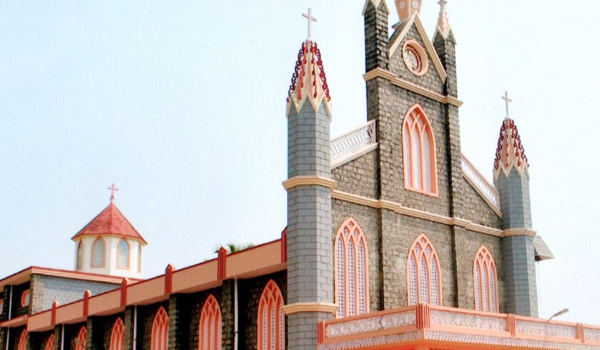
The eparchy consists of nine civil districts of Karnataka state with a vast geographical area of 51,950 square kilometers. The civil districts are South Kanara (Dakshina Kannada), Chamarajnagar, Chickmagalur, Hassan, Kodagu, Mandya, Mysore, Shimoga and Udupi. It has two ecclesiastical districts of South Kanara (Dakshina Kannada) and Shimoga.
The region is full of scenic forests and the numerous rivers that originate with abundant natural beauty. The land is suitable for agriculture. Nethravathi, Kumaradhara, Palguni, Shambavi, Hemavathi, Kabini and Kaveri are some of the famous rivers that run through this land.
Puttur got its name after pearl 'Mutthu' in Kannada language. The 'Place of pearl' or 'Mutthur' slowly evolved itself to Puttur.
The total population of Puttur diocese was 14,310,166. Out of that just 2,500 are Malankara Catholics which makes around 0.018 percent). As many as 800 families come under the 22 parishes of this diocese, most of whom were migrants from Kerala.
Kannada, which is the official state language of Karnataka, is the main language across the geographical diocese spoken by the majority. Malayalam is the official language of the diocese. There are people who speak Tamil, Telugu, Tulu, Konkanni, Kodava, Beary basha and English.
The Church in India traces its origin to the missionary endeavors of St. Thomas the Apostle who arrived in India in 52 AD. Due to this apostolic foundation, the ancient Christian community in India was known as the St. Thomas Christians. A movement to Latinize the Indian Church, with the arrival of Portuguese missionaries resulted in a schism and a portion of this undivided community eventually came into contact with the Jacobites under the Patriarch of Antioch.
There were many attempts for reunion with the Catholic Church ever since the split. The efforts of Archbishop Mar Ivanios and Bishop Jacob Mar Theophilos paved way to the historical event of 'Reunion Movement' in the Malankara Church. On Sept. 20, 1930, the Universal Church received the Malankara Church into the Catholic communion with its liturgy, customs and jurisdiction. As the Reunion Movement developed, Pope Pius XI established the Syro-Malankara Catholic Hierarchy for the reunited people and established the archeparchy of Trivandrum and the eparchy of Tiruvalla by the Apostolic Constitution Christo Pastorum Principi of June 11, 1932.
The migration of people from Kerala state to the southern parts of Karnataka began in 1950's. In 1967, Father Thomas Thannickakuzhy was sent to South Kanara (Dakshina Kannada) in Karnataka state to work among the Malankara faithful living in this region. Later, it became the part of eparchy of Sulthan Bathery erected in 1978.
Further, there has been a great progress in the evangelization work in Karnataka. However, the distance from the eparchial headquarters as well as the shortage of priests and religious were strong obstacles in organizing the migrated people and founding new missions in this area. In spite of the said difficulties, due to the selfless hard work of priests, both eparchial and religious who belong to the Order of the Imitation of Christ (OIC), and the religious sisters belonging to the congregations of the Sisters of the Imitation of Christ (SIC), the Daughters of Mary (DM), the Deena Sevana Sabha (DSS) and the Holy Spirit Sisters (OSS) there was widespread missionary extension.
In spite of the distance, 22 parishes and mission centers were established together with a few educational institutions to impart a value-based education to the children and youth irrespective of their social, religious and cultural differences. With this growth, there aroused a desire in the faithful of Malankara Church in this region to be organized into an independent eparchy for their ecclesial growth and development.
A separate Syro-Malankara eparchy of Puttur was erected on Jan. 25, 2010, and was inaugurated on April 15, 2010. This is the first and only Syro-Malankara eparchy in Karnataka state.
In May 2012, Karnataka is ruled by pro-Hindu political party of Bharathiya Janata Party (BJP) (since May 2008). It has more than 110 state constituencies out of 224 across the state. During the present political rule, there have been number of cases of attacks on the minorities and their institutions and especially on Christians in South Canara and Udupi Districts of Karnataka.
The diocese has a good network of roads. It is well connected with many national highways connecting to different parts of Karnataka state and India. The Konkan Railway connects the region with Maharastra, Goa, Gujarat, Delhi, Rajasthan and Kerala states.
Canara has a seaport at Panambur near Mangalore. Mangalore International Airport is also nearby.
The region has number of places of tourism importance. The land is known for Hindu temples and Jain Basadhis (places of worship) with multifarious art and architecture. Chennakeshava temple of Belur, Hoysaleshwara temple of Halebidu, Manjunatheshwara temple of Dharmasthala, Thousand Pillar temple of Moodbidri and eight temples (Ashta Matt) of Udupi are some of those.
Agriculture, once a major occupation of the people the districts across the diocese, has now taken back seat because of influx of money from natives settled in other commercial hubs. Significant number of people from some areas work in Gulf (Middle East) countries and other states of India.
The main crops of the area are rice, coconut, arecanut, black pepper, cocoa, sugarcane, jowar, maize, cotton, banana, ragi and pulses.
The literacy rate of the Karnataka state has increased from 66.64 percent in 2001 to 75.60 percent in 2011, according to census 2011.
Yakshagana is the popular folk art of Hindus in Udupi and South Canara districts. The Yakshagana is a night-long dance and drama performance practiced in the region with great fanfare.
Kambala or buffalo race is conducted in water filled rice fields. There are number of other folk dances and songs in each region.